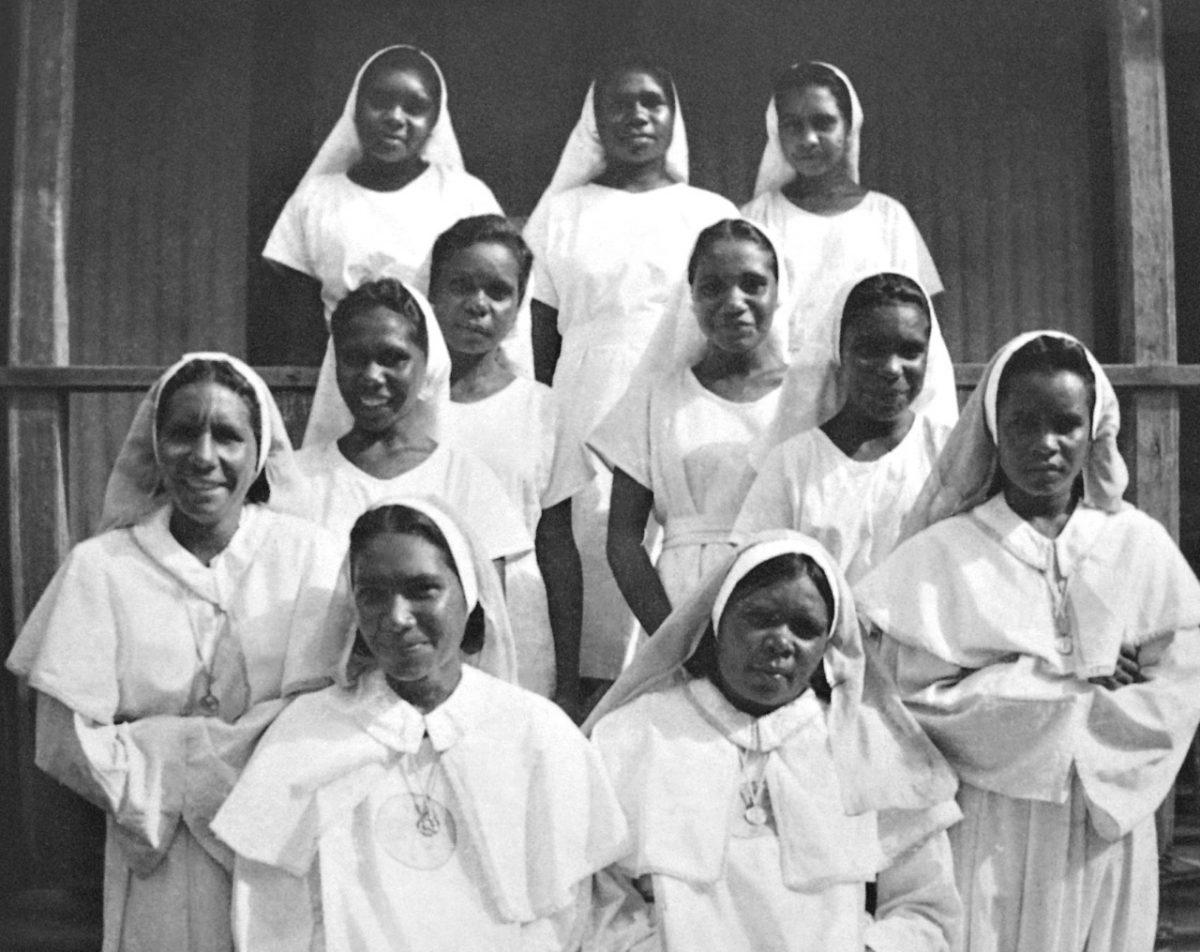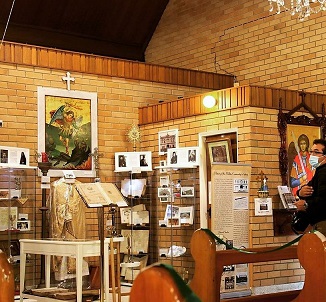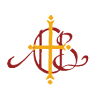Page Contents
Irish dominated Australian Catholicism from the earliest times to at least the early twentieth century, and their cultural reach continued through their Australian descendants. But, also from the earliest times, the Catholic community has been ethnically diverse and the mix of traditions has enriched the Church. Since the beginning of mass non-Anglophone immigration in 1947, the influx of Catholics from a huge range of ethnicities has made the Catholic Church the largest, as well as most varied, church in Australia.
Indigenous
Catholic missions to aboriginal Australians initially converted few adults and in the next generation a degree of hybridised spirituality was sometimes found. But later generations were often brought up at the missions and had a stronger allegiance to them. At New Norcia they included telegraphist Mary Ellen Cuper, and two indigenous seminarians who were sent to Europe but died young.
Indigenous Catholics in mission areas included deacon Boniface Perdjert of Wadeye, Marjorie Liddy, source of the bird image used at World Youth Day 2008, and the members of the indigenous order of nuns in the Kimberley, the Daughters of Our Lady Queen of the Apostles. Miriam Rose Ungunmerr Baumann from the Daly River was named Senior Australian of the Year for 2021.

Census data show that former missions such as Santa Teresa, Wurrumiyanga and Wadeye are now the most Catholic places in Australia with over 85% of the population identifying as Catholic.
In more settled areas, there were sometimes Irish-Aboriginal or “Shamrock Aboriginal” Catholic communities, such as the one described in Warren Mundine’s autobiography in northern New South Wales.
Mum Shirl‘s work for NSW prisoners and Redfern residents in the 1960s to 1990s is legendary.
See also the page on Catholics and indigenous Australians
English
William Ullathorne‘s autobiography From Cabin Boy to Archbishop describes his central role in the Australian church in the 1830s and 1840s. The first two bishops and archbishops of Sydney, Polding and Vaughan. were English Benedictines who attempted to give the Australian church a monastic centre. With the death of Vaughan in 1883 the Benedictine experiment was abandoned and leadership of the Australian Church given to Cardinal Moran and other Irish bishops, priests and nuns.
Catholic laywoman Caroline Chisholm responded to the plight of young immigrant women in 1840s Sydney. Her employment agency found safe jobs for many in city and rural areas. The most recent of several books on her and her work is Sarah Goldman’s Caroline Chisholm (JACHS review).
After Benedictine times, the English never formed a distinctive subgroup of Australian Catholics but a number of individuals made significant contributions.
The English Elizabeth McQuoin founded the Mercy nuns in North Sydney.

William Wardell, an English convert, designed both of the principal Australian Catholic cathedrals, St Mary’s Sydney and St Patrick’s Melbourne. Edward Gell, also a convert, designed many impressive churches and other buildings in the Bathurst region.
Two of the leading mid-twentieth century Catholic controversialists were of English background. Dr Leslie Rumble, born in Sydney to English parents, converted from Anglicanism and as a priest had a long and successful career on radio and in print. Denys Jackson, who grew up in England and converted from Anglicanism, was a prolific writer and broadcaster in Melbourne for decades. A Catholic intellectual leader was Anglo-Australian economist Colin Clark (interview).
Scottish
The Scottish journalist W.A. Duncan established Australia’s first Catholic newspaper, the Australasian Chronicle, in 1839.
Australia’s only canonised saint, Mary MacKillop, was born in Melbourne in 1842 to Flora and Alexander MacKillop, recent immigrants from Scotland. Mary’s letters to her mother are an important source for her life. In 1873 Mary visited the area in Scotland from which her mother came.
MacKillop’s relative Fr Duncan McNab defended the rights of indigenous people in Queensland
The Scottish engineers Charles Gordon O’Neill was largely responsible for establishing the St Vincent de Paul Society in Sydney.
Spanish

(Michal Lewi, Wikimedia Commons)
New Norcia north of Perth is Australia’s only monastic town. Founded by Spanish Benedictines in 1847, it included significant figures such as the founder Dom Rosendo Salvado and his successor as abbot, Fulgencio Torres. They established a mission at Kalumburu in the Kimberley in 1908. Spanish nuns came to New Norcia over many decades, as recounted in Katharine Massam’s A Bridge Between.
Another Spanish missionary, Martin Griver, became Bishop of Perth.
French
The first visits to Australia by Catholic clergy came in the expeditions of La Pérouse in 1788 and Bruni d’Entrecasteaux in 1792.
The Royalist exile Gabriel Louis Marie Huon de Kerilleau was employed to tutor the Macarthurs’ sons in 1807-9.
The revival of Catholic faith in France after the defeat of Napoleon saw the foundation of a large number of Catholic religious orders, several of which spread to Australia in the late nineteenth century. Although those orders soon took on an Australian characteristics, the first generation of French founders were important in the expansion of the Australian Church.
French Marist Fathers and Marist Brothers came to Sydney in the mid-nineteenth century. The Fathers established a headquarters in Hunters Hill for their vast missionary effort in the South Pacific. The Marist Fathers were also given charge of the important inner city church, St Patrick’s, Church Hill. Marist Brothers established a school in Sydney city in 1872 and moved to Hunters Hill in 1881, founding St Joseph’s College.
The Missionaries of the Sacred Heart also arrived with missionary ambitions, mainly in Melanesia. Under the first provincial, the Swiss-French Fr Peter Treand, they established a monastery at Kensington and ministered to neighbouring parishes. Their companion order, the Daughters of Our Lady of the Sacred Heart, began schooling in the same area. The MSC missionary Fr (later Bishop) Gsell a native of Alsace, known for his “purchase” of young promised brides in the Tiwi Islands, recounted his story in The Bishop with 150 Wives.
The Little Sisters of the Poor arrived in Melbourne 1884 and specialised in aged care. French Carmelite nuns arrived in Sydney in 1885.
French Trappists pioneered missions at Beagle Bay in the Kimberley in the 1890s but after great difficulties the work was taken over by German Pallottines.
German
A community of German Catholics established at Sevenhill in South Australia in the 1850s became a centre of the Australian Jesuits.
Ursuline nuns expelled from Germany, where laws against religious education were more severe than in Australia, reached Armidale in 1882 and founded a convent boarding school.
The Beagle Bay mission was taken over by the German Pallottines in 1901, and survived the First World War despite doubts about the missionaries’ loyalty. They built the Bavarian-style Beagle Bay church with its celebrated pearl shell altar. The Church in the Kimberley was in charge of German Vicars Apostolic, Otto Raible and John Jobst, from 1935 to 1995. The Pallottine Fr Ernst Worms did extensive linguistic and anthropological research in the Kimberley.
Melkite and Maronite

Sylwanos Mansour, founder of the Melkite community, arrived in Sydney in 1891. The Melkite Eparchy (diocese) was formed in 1987.
The first Maronite priests arrived in Sydney in 1893 and ministered to the community of Lebanese small traders in the Redfern and Waterloo areas. The Maronite Eparchy was set up in 1973, based at Our Lady of Lebanon Church/Cathedral near Parramatta. Maronites have maintained a strong institutional development and cultural identity.
Italian
Fr Vittorio Riccio of Manila was appointed Prefect Apostolic of Terra Australis in 1681.
Giuseppe alias Angelo Le Rosse was hanged for highway robbery in Sydney in 1814, accompanied to the gallows by a lay Catholic monitor.
Fr Angelo Confalonieri survived shipwreck to live two years near Port Essington as the first Catholic missionary in northern Australia.
Elzear Torreggiani, second bishop of Armidale, 1879-1904, restored harmony in a diocese troubled by scandal. John Cani was appointed first bishop of Rockhampton, like Torregiani in the hope of balancing Irish domination of the Church.
The Apostolic Delegation (papal representation) in Australia was opened in 1914 and almost all the Delegates (later Nuncios) were Italian until 2012. Giovanni Panico, Delegate from 1935 to 1948, oversaw the policy of replacing Irish by Australian bishops.

Australia’s most famous person of Italian descent was B.A. Santamaria, organiser of the mid-twentieth century anticommunist “Movement”. Gerard Henderson’s Santamaria is the definitive biography, while Bruce Duncan’s Crusade or Conspiracy? describes the battles fought. Many of his letters are collected in Patrick Morgan’s B.A. Santamaria: Your Most Obedient Servant. (Santamaria interviewed) His attitude to his Italianness was complex, with his fundamentally Australian commitments nevertheless informed by his Italian background. An early visit to the Aeolian Islands was significant for his faith.
During World War II many Italian Australians were rounded up and interned for a time. Archbishop Mannix took the lead in assisting them. The Italian Jesuit Ugo Modotti was harrassed by the security services and forced to leave Australia. After the War, Fr Giuseppe La Rosa founded La Fiamma newspaper, with a strong anticommunist line.
Lena Santospirito was very active in welfare work for the Italian community in Melbourne in the 1940s and 1950s. Jean Virgona was housekeeper to Archbishop Mannix at Raheen for many years.
Some 350,000 Italians migrated to Australia between 1950 and 1970. The Italian Catholic Federation was formed in 1960 to help provide spiritual assistance to immigrants. (book)
Eastern European
Up to 1947, few immigrants came from the traditionally Catholic countries of Eastern Europe. Fr Leon Rogalski SJ arrived in 1870 to minister to the Polish community in South Australia. Matthew Beovich, born to a Croatian fruiterer in Bendigo in 1896, became Archbishop of Adelaide and guided the diocese through troubled times.
After World War II, Arthur Calwell, Minister for Immigration, instituted a massive immigration program of Eastern European refugees from the Red Army which transformed Australia into its modern multicultural complexion. Many came from the traditionally Catholic countries Poland, Ukraine and Lithuania. Further Communist repression led to waves of immigrants from Hungary in 1956 and Poland around 1980.
A group of Poles, many ex-servicemen, sent to Tasmania in 1947 began mass non-Anglophone immigration to Australia. Polish Catholic life has been vigorous, especially in Sydney and Melbourne, served by a number of priests from Poland. Polish Catholic Australians include Wanda Skowronska, whose Angels, Incense and Revolution: Catholic Schooldays of the 1960s presents a very positive view of an immersive religious education, and linguist Anna Wierzbicka, author of What Christians Believe.
The Byzantine rite Ukrainians form an eparchy (diocese) (history).
Lithuanian Catholic communities in Melbourne and Adelaide were led by Fr Joseph Kungys. (Petition of 1960) They, like Latvian Catholic communities in Sydney, Melbourne and Adelaide, have now integrated into the mainstream.
Filipino
Thomas Puertollano, a Filipino missionary. was crucial to establishing the Church in the Kimberley around 1900.
Immigrants from the Philippines came in large numbers from the 1970s, most of them Catholic. Catholic Church connections were often significant for integration in Australia. The Philippines is the top birthplace of Catholics in Australia born overseas. There are several Filipino Catholic communities in the Western Sydney area and in south-east Queensland.
Chinese
Fr Joseph Ah Lee ministered in Melbourne from 1865.
During the first half of the twentieth century when the White Australia Policy prevented most new Asian immigration, Chinese Catholic communities in Australia remained small but retained cohesion, such as at a 1914 wedding.
A Chinese Catholic Action Group in Sydney was active in 1940 and conducted a Sunday school and social events in 1942. They assisted refugees from Rabaul in 1943 and remained active in 1945, 1948 and 1953.
Chinese priests arrived in 1954 to serve the community. Fr Paschal Chang was largely responsible for founding the Chinese Catholic ministry in Sydney and oversaw its expansion in Ashfield and Haymarket over several decades. The Diamond Jubilee was celebrated in 2014. (publications)
There are now Chinese Catholic communities in all mainland states and the Northern Territory.
Chinese are active in the Catholic Asian Students Society at several Sydney universities.
Greg Homeming became Bishop of Lismore in 2017.
Vietnamese
The close relations of the Catholic Vietnamese President Ngo Dinh Diem with Mannix and Gilroy were significant in building early Australian support for military intervention in South Vietnam. When a million refugees fled communist Vietnam around 1980, Australia accepted a considerable proportion as immigrants.

Van Tuong Nguyen found consolation in his faith before his execution in Singapore in 2005.
Vincent Long Van Nguyen, who fled Vietnam by boat in 1979, was appointed Bishop of Parramatta in 2016.
Korean
Korean Catholic communities have been established in Sydney, Broken Bay, Melbourne, Brisbane and Canberra.
East Timorese
After the Indonesian invasion of East Timor in 1975, many refugees came to Australia. The support of Australian Catholics was significant in preserving the hope of independence through the occupation, and the Australian military intervention in 1999 was crucial in securing independence for Asian’s second Christian nation. Many refugees then returned, but a community still exist in Brisbane.
Latin American
Immigration in large numbers began from Chile in the 1970s and Central America in the 1980s, following politically disturbed times in those countries. Sydney and Brisbane.
A Brazilian Catholic community exists in Brisbane.
Middle Eastern
Disturbed times in Iraq and Syria since the war of 2003 caused the flight of many Middle Eastern Christians. Chaldeans in Western Sydney and Melbourne support the Chaldean Eparchy. A Syriac community has settled in Sydney.
Indian
“Louis Peter, a native of India and Roman Catholic” was a witness in a legal case in 1810.
Considerable numbers of Indian priests have come to Australia in recent years, especially from Kerala. The Syro-Malabar Eparchy was established in Melbourne in 2014.
Pacific Islander
Sydney has a Fijian Catholic community
